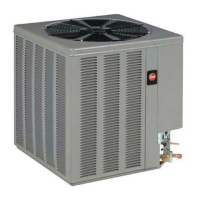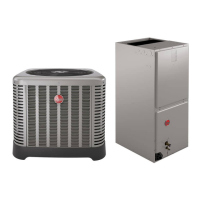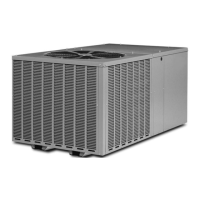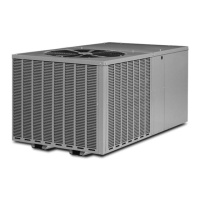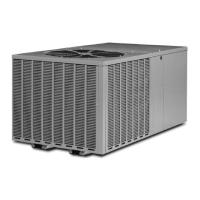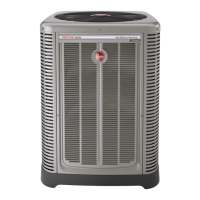11
7.0 INTERCONNECTING TUBING
7.1 VAPOR AND LIQUID LINES
Keep all lines sealed until connection is made.
Make connections at the indoor coil first.
Refer to Line Size Information in Tables 2 and 3 for correct size and multipliers to be
used to determine capacity for various vapor line diameters and lengths of run. The
losses due to the lines being exposed to outdoor conditions are not included.
The factory refrigeration charge in the outdoor unit is sufficient for 15 feet [4.6 m] of
interconnecting lines. The factory refrigeration charge in the outdoor unit is sufficient
for the unit and 15 feet [4.6 m] of standard size interconnecting liquid and vapor
lines. For different lengths, adjust the charge as indicated below.
1/4” ± .3 oz. per foot [6.35 mm ± 8.5 g]
5/16” ± .4 oz. per foot [7.9 mm ± 11.3 g]
3/8” ± .6 oz. per foot [9.5 mm ± 17 g]
1/2” ± 1.2 oz. per foot [12.7 mm ± 34 g]
7.2 MAXIMUM LENGTH OF LINES
The maximum length of interconnecting line is 150 feet [45.7 m]. Always use the
shortest length possible with a minimum number of bends. Additional compressor
oil is not required for any length up to 150 feet [45.7 m].
NOTE: Excessively long refrigerant lines cause loss of equipment capacity.
7.3 VERTICAL SEPARATION
Keep the vertical separation to a minimum. Use the following guidelines when
installing the unit:
1. DO NOT exceed the vertical separations as indicated on Table 3.
2. It is recommended to use the smallest liquid line size permitted to minimize sys-
tem charge which will maximize compressor reliability.
3. Table 3 may be used for sizing horizontal runs.
7.4 TUBING INSTALLATION
Observe the following when installing correctly sized type “L” refrigerant tubing
between the condensing unit and evaporator coil:
• If a portion of the liquid line passes through a hot area where liquid refrigerant
can be heated to form vapor, insulating the liquid line is required.
• Use clean, dehydrated, sealed refrigeration grade tubing.
• Always keep tubing sealed until tubing is in place and connections are to be
made.
• Blow out the liquid and vapor lines with dry nitrogen before connecting to the
outdoor unit and indoor coil. Any debris in the line set will end up plugging the
expansion device.
• As an added precaution it is recommended that a high quality, bi-directional fil-
ter drier is installed in the liquid line.
• Do not allow the vapor line and liquid line to be in contact with each other. This
causes an undesirable heat transfer resulting in capacity loss and increased
power consumption. The vapor line must be insulated.
• If tubing has been cut, make sure ends are deburred while holding in a position
to prevent chips from falling into tubing. Burrs such as those caused by tubing
cutters can affect performance dramatically, particularly on small liquid line
sizes.
• For best operation, keep tubing run as short as possible with a minimum num-
ber of elbows or bends.
• Locations where the tubing will be exposed to mechanical damage should be
avoided. If it is necessary to use such locations, the copper tubing should be
housed to prevent damage.

